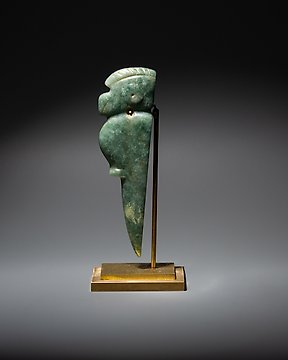
Nicoya-Guanacaste, Jade Pendentif aviforme, v. 300 à 500 après JC. 10 cm. Licence d'exportation espagnole.
Nº 84324095

Nº 84324095

Anthropomorphic Hachoid Pendant.
- Important Piece! -
- Export License -
- Intact -
Nicoya - Guanacaste, Costa Rica. c. 300 - 500 AD.
Jade stone.
11.5 cm length.
PROVENANCE:
- Private collection, USA
- Banks - Primitive Inc., Maryland, USA, September 30, 1994.
- Private collection, Remy Rey, London, United Kingdom. Acquired from the previous one.
CONDITION: Intact.
BIBLIOGRAPHY:
- FERNÁNDEZ, P.; ALVARADO, G.E. Artisans and Stones: Pre-Columbian Tools and Sculpture in Costa Rica. Central Bank of Costa Rica Museums Foundation. 2006.
- FERRERO, L. Pre-Columbian Costa Rica: archeology, ethnology, technology, art. Costa Rica Publishing. 2000.
DESCRIPTION:
A jade (jadeite) carved pendant decorated with engraved motifs on the front and a cut-out upper profile. It is a hachoid design, with the general shape of a sumptuary axe - rounded lower edge, flat shape - and a carved upper edge with a figurative profile. This profile shows, on one of its fronts, a possibly human face, with a large differentiated nose, a closed straight mouth and an eye represented by a rounded perforation. The rest of the ornamental elements, which include an earflare with a spiral design, have been worked with engraved lines, without relief. These lines also continue on the lower part of the axe, which is decorated with parallel lines perpendicular to the blade. The pendant has two suspension holes that open obliquely at the back, ending at the top edge of the piece, so that it would be shown hanging horizontally.
In Mesoamerica, jade necklaces were objects of great symbolic importance on a ritual and social level, a material representation of the high rank of their wearers. They were therefore used exclusively by chiefs, nobles and priests, as well as their families. These necklaces usually combined beads of different designs with a central pendant arranged vertically, carved to represent a human or animal figure, with the limbs folded over the belly, or in the form of a flat-edged axe, of a symbolic nature. There are also mixed representations that combine a flat, lower-edged axe structure with an upper part carved with the features of a character or animal (usually birds). These pendants were usually pierced on the sides, so that they hung frontally.
Green-coloured stone was considered sacred in Mesoamerica; it was associated with water, the fertility of maize and life, and thus linked to the preservation of the agricultural cycle. The most prized of these stones was jade (jadeite), considered more valuable than gold and a key religious, political and economic material throughout the region. It was reserved for the adornment of gods and kings, and even the latter could only wear it on certain occasions. Considered to be a symbol of life and purity, jade was used in particular to make jewellery such as pendants, nose rings and ear flares. Jadeite pendants were therefore highly valued objects, charged with symbolic and religious significance and only displayed by the most powerful members of society.
Jadeite is an extremely dense rock, with a relative hardness value equivalent to that of steel. Occasionally it is translucent, and its surface acquires greater chromatic intensity, as well as exceptional lustre and smoothness, after a prolonged process of weathering, polishing and burnishing. The only known source of jadeite in ancient Mesoamerica is in the valley of the Motagua River in present-day Guatemala. The first jadeite was probably found there in the form of boulders, before systematic extraction began.
Greater Nicoya is an archaeological region covering northwestern Costa Rica and the Pacific coast of Nicaragua. The Southern Sub-region, or Guanacaste, occupies the Nicoya Peninsula, the Tempisque River basin and the Guanacaste and Tilaran mountain ranges. It is an area that has been occupied by humans for some 10,000 years, with important remains of material culture in ceramics, carved stone and jade from the Tempisque period (500-300 BC). In the Bagaces period (300-800 AD) there was already a complex social organisation reflected in a greater variety of burial formulas, which included the use of large stone blocks. Around 800 AD, the territory of Guanacaste was occupied by Chorotega groups from the north, from the Valley of Mexico, who were fleeing Olmec domination. This migration brought the cultural influence of the Maya and formed the seed of the Kingdom of Nicoya, one of the main pre-Columbian chiefdoms in Mesoamerica at the time of the arrival of the Spanish.
Notes:
- The piece includes authenticity certificate.
- The piece includes Spanish Export License.
- The seller guarantees that he acquired this piece according to all national and international laws related to the ownership of cultural property. Provenance statement seen by Catawiki.
Comment acheter sur Catawiki ?
1. Découvrez des objets d’exception
2. Faites la meilleure offre
3. Effectuez un paiement sécurisé